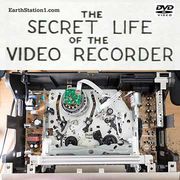The Secret Life Of The Video Recorder (VCR, VTR) DVD, MP4, USB Drive
9.69
USD. Free Shipping Worldwide!
The Secret LIfe Of The VCR (Videocassette Recorder, Video Recorder): How It Works, How It Came About, Its Unlikely Lineage And Its Ultimate Development Into The Standard Home Appliance Of The Late 20th To Early 21st Century, As Told By The Beloved Iconic 1988-1993 British Television Series The Secret Life Of Machines, Presented In The Highest DVD Quality MPG Video Format Of 9.1 MBPS As An Archival Quality All Regions Format DVD, MP4 Video Download Or USB Flash Drive! (Color, 1990, 23 Minutes.) #VCRs #VideoRecorders #VideoRecording #VideoRecordings #VideoCassetteRecorders #VCRDay #HomeVideo #Video #SecretLifeOfMachines #DVD #VideoDownload #MP4 #USBFlashDrive
A Videocassette Recorder (VCR) or video recorder is an electromechanical device that records analog audio and analog video from broadcast television or other source on a removable, magnetic tape videocassette, and can play back the recording. Use of a VCR to record a television program to play back at a more convenient time is commonly referred to as timeshifting. VCRs can also play back prerecorded tapes. In the 1980s and 1990s, prerecorded videotapes were widely available for purchase and rental, and blank tapes were sold to make recordings. Most domestic VCRs are equipped with a television broadcast receiver (tuner) for TV reception, and a programmable clock (timer) for unattended recording of a television channel from a start time to an end time specified by the user. These features began as simple mechanical counter-based single-event timers, but were later replaced by more flexible multiple-event digital clock timers. In later models, the multiple timer events could be programmed through a menu interface displayed on the playback TV screen ("on-screen display" or OSD). This feature allowed several programs to be recorded at different times without further user intervention, and became a major selling point.
A Video Tape Recorder (VTR) is a tape recorder designed to record and play back video and audio material from magnetic tape. The early VTRs were open-reel devices that record on individual reels of 2-inch-wide (5.08 cm) tape. They were used in television studios, serving as a replacement for motion picture film stock and making recording for television applications cheaper and quicker. Beginning in 1963, videotape machines made instant replay during televised sporting events possible. Improved formats, in which the tape was contained inside a videocassette, were introduced around 1969; the machines which play them are called videocassette recorders. Agreement by Japanese manufacturers on a common standard recording format, so cassettes recorded on one manufacturer's machine would play on another's, made a consumer market possible; and the first consumer videocassette recorder, which used the U-matic format, was introduced by Sony in 1971.
The Secret LIfe Of The VCR (Videocassette Recorder, Video Recorder): How It Works, How It Came About, Its Unlikely Lineage And Its Ultimate Development Into The Standard Home Appliance Of The Late 20th To Early 21st Century, As Told By The Beloved Iconic 1988-1993 British Television Series The Secret Life Of Machines, Presented In The Highest DVD Quality MPG Video Format Of 9.1 MBPS As An Archival Quality All Regions Format DVD, MP4 Video Download Or USB Flash Drive! (Color, 1990, 23 Minutes.) #VCRs #VideoRecorders #VideoRecording #VideoRecordings #VideoCassetteRecorders #VCRDay #HomeVideo #Video #SecretLifeOfMachines #DVD #VideoDownload #MP4 #USBFlashDrive
A Videocassette Recorder (VCR) or video recorder is an electromechanical device that records analog audio and analog video from broadcast television or other source on a removable, magnetic tape videocassette, and can play back the recording. Use of a VCR to record a television program to play back at a more convenient time is commonly referred to as timeshifting. VCRs can also play back prerecorded tapes. In the 1980s and 1990s, prerecorded videotapes were widely available for purchase and rental, and blank tapes were sold to make recordings. Most domestic VCRs are equipped with a television broadcast receiver (tuner) for TV reception, and a programmable clock (timer) for unattended recording of a television channel from a start time to an end time specified by the user. These features began as simple mechanical counter-based single-event timers, but were later replaced by more flexible multiple-event digital clock timers. In later models, the multiple timer events could be programmed through a menu interface displayed on the playback TV screen ("on-screen display" or OSD). This feature allowed several programs to be recorded at different times without further user intervention, and became a major selling point.
A Video Tape Recorder (VTR) is a tape recorder designed to record and play back video and audio material from magnetic tape. The early VTRs were open-reel devices that record on individual reels of 2-inch-wide (5.08 cm) tape. They were used in television studios, serving as a replacement for motion picture film stock and making recording for television applications cheaper and quicker. Beginning in 1963, videotape machines made instant replay during televised sporting events possible. Improved formats, in which the tape was contained inside a videocassette, were introduced around 1969; the machines which play them are called videocassette recorders. Agreement by Japanese manufacturers on a common standard recording format, so cassettes recorded on one manufacturer's machine would play on another's, made a consumer market possible; and the first consumer videocassette recorder, which used the U-matic format, was introduced by Sony in 1971.
